NetworkX
来源:互联网 发布:淘宝好点的男装店 编辑:程序博客网 时间:2024/05/23 01:16
常用网站:
- 官方文档
- Github (latest development)
NetworkX官方介绍:
========
NetworkX (NX) is a Python package for the creation, manipulation, andstudy of the structure, dynamics, and functions of complex networks.<https://networkx.lanl.gov/> Just write in Python >>> import networkx as nx >>> G=nx.Graph() >>> G.add_edge(1,2) >>> G.add_node(42) >>> print(sorted(G.nodes())) [1, 2, 42] >>> print(sorted(G.edges())) [(1, 2)]- 用来处理无向图、有向图、多重图的Python数据结构
- 包含许多标准的图算法
- 包括网络结构和分析方法
- 用于产生经典图、随机图和综合网络
- 节点可以是任何事物(如text, images, XML records)
- 边能保存任意起算值(如weights, time-series)
- 开源证书 BSD license
- 很好的测试结果:超过1800个单元测试,90%的结点覆盖
- 从Python获得的额外优势:快速原型开发方法,容易学,支持多平台。
import networkx as nxG = nx.Graph()G.add_edge('A', 'B', weight=4)G.add_edge('B', 'D', weight=2)G.add_edge('A', 'C', weight=3)G.add_edge('C', 'D', weight=4)nx.shortest_path(G, 'A', 'D', weight='weight')['A', 'B', 'D']import networkx as nxG=nx.Graph()G.add_edge(1,2)G.add_node(42)print(sorted(G.nodes()))print(sorted(G.edges()))[1, 2, 42][(1, 2)]创建图
import networkx as nxG=nx.Graph()Graph是结点(向量)与确定的结点对(称作边、链接等)的集合。
在Networkx中,结点可以是任何可哈希的对象,如文本字符串、图片、XML对象、其他图,自定义对象等。
注意:python的None对象不应该用作结点,
可哈希的:一个对象在它的生存期从来不会被改变(拥有一个哈希方法),能和其他对象区别(有比较方法)
结点
Neatworkx包含很多图生成器函数和工具,可用来以多种格式来读写图。
一次增加一个节点:
G.add_node(1)
用序列增加一系列的节点
G.add_nodes_from([2,3])
增加 nbunch结点。
nbunch是可迭代的结点容器 (序列、集合、图、文件等),其本身不是图的某个节点
import networkx as nxG=nx.Graph()G.add_node(1)G.add_nodes_from([2,3])H=nx.path_graph(10) # type(H) networkx.classes.graph.GraphG.add_nodes_from(H) # 这是将H中的许多结点作为G的节点G.add_node(H) # 这是将H作为G中的一个节点#查看结点G.node{1: {}, 2: {}, 3: {}, 0: {}, 4: {}, 5: {}, 6: {}, 7: {}, 8: {}, 9: {}, <networkx.classes.graph.Graph at 0x18ecbb89940>: {}}#G能够一次增加一条边G.add_edge(1,2) #只能增加边,有属性,除非指定属性名和值“属性名=值”e=(2,3)G.add_edge(*e) #注意! G.add_edge(e)会报错!G.add_edge(e)#用序列增加一系列结点G.add_edges_from([(1,2),(1,3)])#增加 ebunch边。ebunch:包含边元组的容器,比如序列、迭代器、文件等#这个元组可以是2维元组或 三维元组 (node1,node2,an_edge_attribute_dictionary),an_edge_attribute_dictionary比如:#{‘weight’:3.1415}G.add_edges_from(H.edges())删除
G.remove_node(),G.remove_nodes_from()G.remove_edge(),G.remove_edges_from()G.remove_node(H) #删除不存在的东西会报错#移除所有的节点和边G.clear()G.add_edges_from([(1,2),(1,3)])G.add_node(1)G.add_edge(1,2)G.add_node("spam")G.add_nodes_from("spam") # adds 4 nodes: 's', 'p', 'a', 'm'G.edges(),G.nodes(),G.number_of_edges(),G.number_of_nodes()import networkx as nx<module 'networkx' from 'D:\\ProgramData\\Anaconda3\\lib\\site-packages\\networkx\\__init__.py'>无向图
import networkx as nximport matplotlib.pyplot as pltG = nx.Graph() #建立一个空的无向图GG.add_node(1) #添加一个节点1G.add_edge(2,3) #添加一条边2-3(隐含着添加了两个节点2、3)G.add_edge(3,2) #对于无向图,边3-2与边2-3被认为是一条边print ("nodes:", G.nodes()) #输出全部的节点: [1, 2, 3]print ("edges:", G.edges()) #输出全部的边:[(2, 3)]print ("number of edges:", G.number_of_edges()) #输出边的数量:1nx.draw(G)plt.savefig("wuxiangtu.png")plt.show()nodes: [1, 2, 3]edges: [(2, 3)]number of edges: 1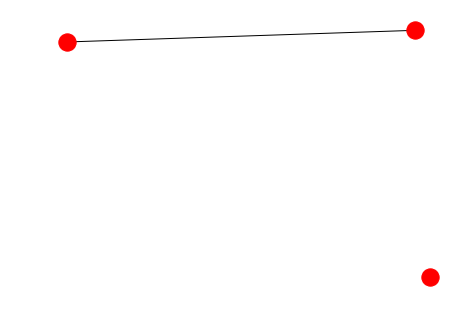
#-*- coding:utf8-*- import networkx as nximport matplotlib.pyplot as pltG = nx.DiGraph()G.add_node(1)G.add_node(2) #加点G.add_nodes_from([3,4,5,6]) #加点集合G.add_cycle([1,2,3,4]) #加环G.add_edge(1,3) G.add_edges_from([(3,5),(3,6),(6,7)]) #加边集合nx.draw(G)plt.savefig("youxiangtu.png")plt.show()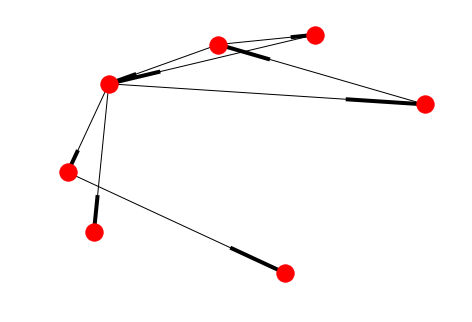
有向图
#!-*- coding:utf8-*- import networkx as nximport matplotlib.pyplot as pltG = nx.DiGraph()G.add_node(1)G.add_node(2)G.add_nodes_from([3,4,5,6])G.add_cycle([1,2,3,4])G.add_edge(1,3)G.add_edges_from([(3,5),(3,6),(6,7)])nx.draw(G)plt.savefig("youxiangtu.png")plt.show()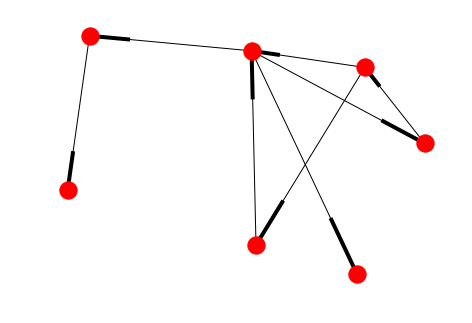
注:有向图和无向图可以互相转换,使用函数:
Graph.to_undirected()Graph.to_directed()
# 例子中把有向图转化为无向图import networkx as nximport matplotlib.pyplot as pltG = nx.DiGraph()G.add_node(1)G.add_node(2)G.add_nodes_from([3,4,5,6])G.add_cycle([1,2,3,4])G.add_edge(1,3)G.add_edges_from([(3,5),(3,6),(6,7)])G = G.to_undirected()nx.draw(G)plt.savefig("wuxiangtu.png")plt.show()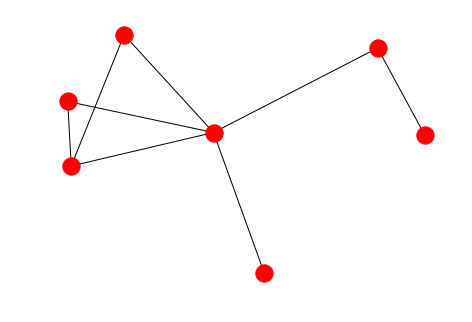
#-*- coding:utf8-*-import networkx as nximport matplotlib.pyplot as pltG = nx.DiGraph()road_nodes = {'a': 1, 'b': 2, 'c': 3}#road_nodes = {'a':{1:1}, 'b':{2:2}, 'c':{3:3}}road_edges = [('a', 'b'), ('b', 'c')]G.add_nodes_from(road_nodes.items())G.add_edges_from(road_edges)nx.draw(G)plt.savefig("youxiangtu.png")plt.show()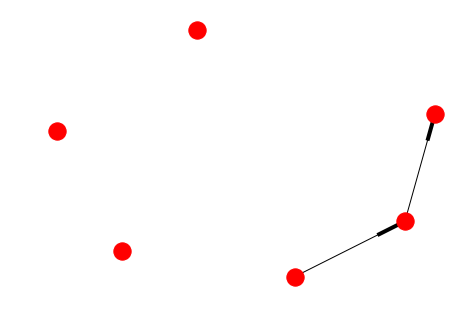
#-*- coding:utf8-*-import networkx as nximport matplotlib.pyplot as pltG = nx.DiGraph()#road_nodes = {'a': 1, 'b': 2, 'c': 3}road_nodes = {'a':{1:1}, 'b':{2:2}, 'c':{3:3}}road_edges = [('a', 'b'), ('b', 'c')]G.add_nodes_from(road_nodes.items())G.add_edges_from(road_edges)nx.draw(G)plt.savefig("youxiangtu.png")plt.show()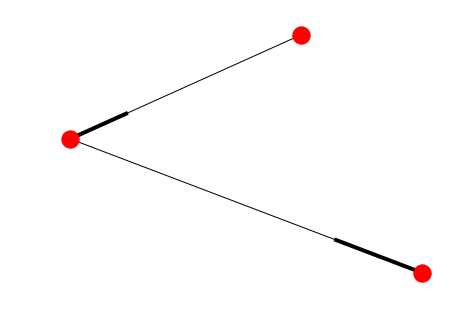
加权图
有向图和无向图都可以给边赋予权重,用到的方法是add_weighted_edges_from,它接受1个或多个三元组[u,v,w]作为参数,
其中u是起点,v是终点,w是权重
#!-*- coding:utf8-*- import networkx as nximport matplotlib.pyplot as pltG = nx.Graph() #建立一个空的无向图GG.add_edge(2,3) #添加一条边2-3(隐含着添加了两个节点2、3)G.add_weighted_edges_from([(3, 4, 3.5),(3, 5, 7.0)]) #对于无向图,边3-2与边2-3被认为是一条边print (G.get_edge_data(2, 3))print (G.get_edge_data(3, 4))print (G.get_edge_data(3, 5))nx.draw(G)plt.savefig("wuxiangtu.png")plt.show(){}{'weight': 3.5}{'weight': 7.0}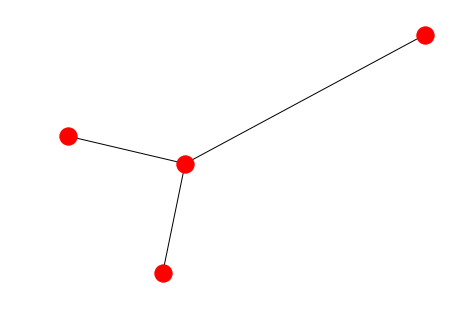
import networkx as nximport matplotlib.pyplot as pltG = nx.DiGraph()经典图论算法计算
计算1:求无向图的任意两点间的最短路径
# -*- coding: cp936 -*-import networkx as nximport matplotlib.pyplot as plt #计算1:求无向图的任意两点间的最短路径G = nx.Graph()G.add_edges_from([(1,2),(1,3),(1,4),(1,5),(4,5),(4,6),(5,6)])path = nx.all_pairs_shortest_path(G)print(path[1]){1: [1], 2: [1, 2], 3: [1, 3], 4: [1, 4], 5: [1, 5], 6: [1, 4, 6]}计算2:找图中两个点的最短路径
import networkx as nxG=nx.Graph()G.add_nodes_from([1,2,3,4])G.add_edge(1,2)G.add_edge(3,4)try: n=nx.shortest_path_length(G,1,4) print (n)except nx.NetworkXNoPath: print ('No path')No path强连通、弱连通
- 强连通:有向图中任意两点v1、v2间存在v1到v2的路径(path)及v2到v1的路径。
- 弱联通:将有向图的所有的有向边替换为无向边,所得到的图称为原图的基图。如果一个有向图的基图是连通图,则有向图是弱连通图。
距离
例1:弱连通
#-*- coding:utf8-*- import networkx as nximport matplotlib.pyplot as plt#G = nx.path_graph(4, create_using=nx.Graph())#0 1 2 3G = nx.path_graph(4, create_using=nx.DiGraph()) #默认生成节点0 1 2 3,生成有向变0->1,1->2,2->3G.add_path([7, 8, 3]) #生成有向边:7->8->3for c in nx.weakly_connected_components(G): print (c)print ([len(c) for c in sorted(nx.weakly_connected_components(G), key=len, reverse=True)])nx.draw(G)plt.savefig("youxiangtu.png")plt.show(){0, 1, 2, 3, 7, 8}[6]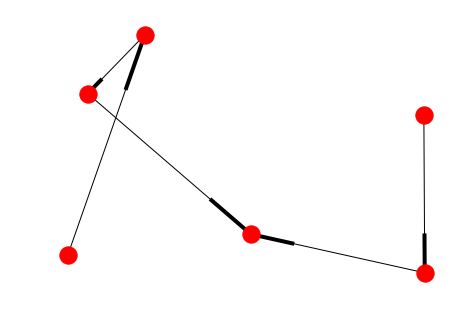
例2:强连通
#-*- coding:utf8-*- import networkx as nximport matplotlib.pyplot as plt#G = nx.path_graph(4, create_using=nx.Graph())#0 1 2 3G = nx.path_graph(4, create_using=nx.DiGraph())G.add_path([3, 8, 1])#for c in nx.strongly_connected_components(G):# print c##print [len(c) for c in sorted(nx.strongly_connected_components(G), key=len, reverse=True)]con = nx.strongly_connected_components(G)print (con)print (type(con))print (list(con))nx.draw(G)plt.savefig("youxiangtu.png")plt.show()<generator object strongly_connected_components at 0x0000018ECC82DD58><class 'generator'>[{8, 1, 2, 3}, {0}]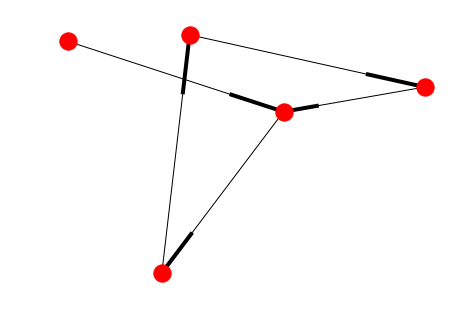
子图
#-*- coding:utf8-*- import networkx as nximport matplotlib.pyplot as pltG = nx.DiGraph()G.add_path([5, 6, 7, 8])sub_graph = G.subgraph([5, 6, 8])#sub_graph = G.subgraph((5, 6, 8)) #ok 一样nx.draw(sub_graph)plt.savefig("youxiangtu.png")plt.show()
条件过滤
原图
#-*- coding:utf8-*-import networkx as nximport matplotlib.pyplot as pltG = nx.DiGraph()road_nodes = {'a':{'id':1}, 'b':{'id':1}, 'c':{'id':3}, 'd':{'id':4}}road_edges = [('a', 'b'), ('a', 'c'), ('a', 'd'), ('b', 'd')]G.add_nodes_from(road_nodes)G.add_edges_from(road_edges)nx.draw(G)plt.savefig("youxiangtu.png")plt.show()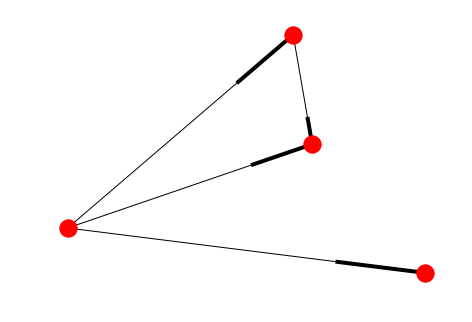
过滤函数
#-*- coding:utf8-*-import networkx as nximport matplotlib.pyplot as pltG = nx.DiGraph()def flt_func_draw(): flt_func = lambda d: d['id'] != 1 return flt_funcroad_nodes = {'a':{'id':1}, 'b':{'id':1}, 'c':{'id':3}, 'd':{'id':4}}road_edges = [('a', 'b'), ('a', 'c'), ('a', 'd'), ('b', 'd')]G.add_nodes_from(road_nodes.items())G.add_edges_from(road_edges)flt_func = flt_func_draw()part_G = G.subgraph(n for n, d in G.nodes_iter(data=True) if flt_func(d))nx.draw(part_G)plt.savefig("youxiangtu.png")plt.show()
pred,succ
#-*- coding:utf8-*-import networkx as nximport matplotlib.pyplot as pltG = nx.DiGraph()road_nodes = {'a':{'id':1}, 'b':{'id':1}, 'c':{'id':3}}road_edges = [('a', 'b'), ('a', 'c'), ('c', 'd')]G.add_nodes_from(road_nodes.items())G.add_edges_from(road_edges)print( G.nodes())print (G.edges())print ("a's pred ", G.pred['a'])print ("b's pred ", G.pred['b'])print ("c's pred ", G.pred['c'])print ("d's pred ", G.pred['d'])print ("a's succ ", G.succ['a'])print ("b's succ ", G.succ['b'])print ("c's succ ", G.succ['c'])print ("d's succ ", G.succ['d'])nx.draw(G)plt.savefig("wuxiangtu.png")plt.draw()['a', 'b', 'c', 'd'][('a', 'b'), ('a', 'c'), ('c', 'd')]a's pred {}b's pred {'a': {}}c's pred {'a': {}}d's pred {'c': {}}a's succ {'b': {}, 'c': {}}b's succ {}c's succ {'d': {}}d's succ {}阅读全文
0 0
- networkx
- networkx
- NetworkX
- NetworkX画图
- 安装networkx
- networkx笔记
- networkx笔记
- Networkx绘图
- NetworkX使用手册
- Networkx参考手册
- NetworkX Study
- Networkx-cycle
- networkx学习
- python networkx学习
- windows7安装networkx
- networkx的文章
- Ubuntu安装Networkx
- [Python]networkx入门
- Eclipse 在线安装SVN的(SVN CONNECTOR按官方指引不成功)
- 【Java学习笔记】31:查漏补缺3(传值和传引用,Eclipse单步调试)
- Video.js调整视频封面大小的问题
- 用webpack搭建Vue2.x开发框架
- tomcat手工启动及修改端口
- NetworkX
- 入职YZ前
- tomcat和Jboss7的区别
- 51nod 1524 可除图的最大团 dp
- 解密智慧工程中的SaaS应用
- HDU 5826 速度+加速度+积分
- Android初级开发(九)——网络交互—解析JSON格式数据
- 电池热失控
- Python入门 HelloWorld


